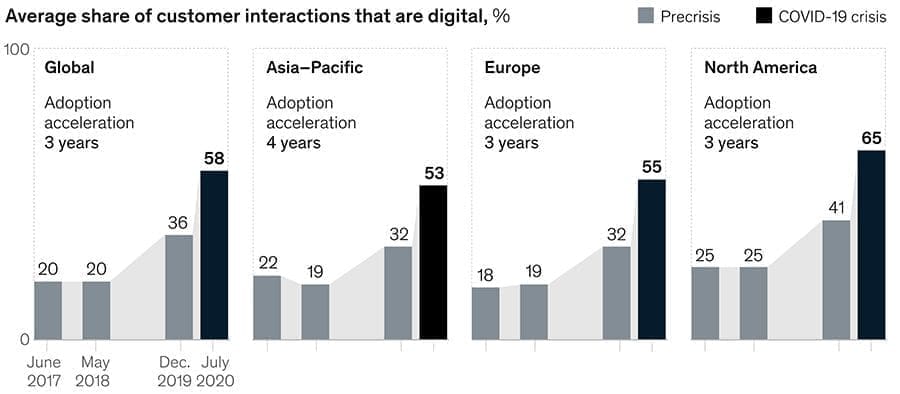As we recover from uncertainty, and with a looming global recession many IT Budgets are still frozen. Here’s what Digital leaders must do NOW to optimize digital transformation after the pandemic.
Essentially, 2020 became 2025 on the digital acceleration timeline. The good news: much of the foundational work that is critical for successful digital transformation efforts has already started taking root.
Source : www.consultancy.uk
How Did the Pandemic Affect Digital Transformation?
There is no doubt that Covid 19 pandemic impacted business and IT spend. Businesses are going through an elongated period of uncertainty and sales have taken a hit. In response, the CFO and CEO needs every department to cut costs and stop ‘unnecessary’ spending.
That means no new hires, getting rid of underused or high-priced software licenses, and an overall IT spending freeze. Hardly ideal when most industries are currently going through sweeping digital transformation.
There is a very high chance that while enterprise software spending is paused, competitors will gain an irreconcilable competitive advantage. An enticingly high tech-stack ROI doesn’t exist when you’re too late to the party.
When it comes to business transformation, if you want to remain competitive, you need to be two steps ahead of the competition. However, without budget to support digital transformation and software improvements, this is difficult, if not impossible. As the pandemic comes to a close, and we can see that the end is finally in sight, what activities can organizations do NOW to to prepare for future digital transformation? The answer is, a lot.
5 Ways to Prepare Your Organization for Future Digital Transformation
Competitors may hibernate and wait for things to blow over. When they freeze, everything slows or shuts down, but that’s not the only option. Spending freezes mean the finances stop, but nothing else. Despite how it might initially seem, there are benefits to short-term pauses. Diligent CIOs and leaders will gain a competitive edge by taking advantage of a lean approach to digital transformation.
1. Picture, Plan and Prepare for Post Pandemic Digital Transformation
The companies, CIOs, and digital transformation leaders who use freeze times wisely will come out the other end far ahead of competitors. Don’t waste your time. Picture, plan and prepare for future digital transformation initiatives.
Make a plan of how you will use this time. As the CIO, you should include:
- Conducting an internal IT Analysis
- Identifying legacy software
- Shedding unnecessary or outdated technology
- Surveying your business needs
- Strategizing for the future
- Gathering your most important requirements
2. Define Future Software Needs
Your team can do all the work preceding a contract signing so mobilize them quickly. Right now is actually the least costly time for you to conduct an analysis and source new software. Your staff are not taking time away from immediate value-generating tasks to analyze and gather requirements.
Take the opportunity to figure out what legacy software needs to be replaced and what you are going to replace it with. Perform a deep analysis to understand the problems and gather the requirements of the perfect solution. The more specific you can be, the better suited the updated software can be.
3. Detailed Collaborative Requirements Gathering and Ranking
Have your IT team interview all the relevant stakeholders on what they need. Get definitive features and attributes that will save time and costs for the whole department going forward. What added benefits could bring the department and company to the next level? Using the Olive platform to collaborate, you can make this process more efficient and drive user engagement.
Leverage Your Team to Dig Deep Into Requirements
A budget freeze and company slowdown affect financial assets but not human capital. You will find that the slowed business activity means there are fewer demands on your department.
With less daily tasks, you have more staff hours at your disposal. This is your best resource for generating added value during a freeze. Use your resources to dig deeper into your requirements.
Ranking Requirements
Once you have a clear list of defined needs, put them in a ranked order. What are the absolute must-haves? At Olive, we use these critical requirements to exclude any software that does not provide these abilities, so you don’t waste any time or resources on mismatched vendors.
The Future of Digital Transformation Depends On Organizational Buy-In
4. Assess all the Market Options
Now you know exactly what you need to find a suitable vendor. Make a list of the options that satisfy your criteria. Be flexible starting out. Often you’ll find your needs can be serviced in different ways by less established providers. Just because they didn’t pay to appear on a magic quadrant, or at the top of industry lists, does not mean they won’t be a better fit for your needs.
Don’t rely only on the market evaluation platforms because they are rife with bias. Each vendor on your search results has paid to be there, and their reviews are based on how well the option worked for their business needs, not your business needs. In the world of software, one size does not fit all. You need to select software that best fits your unique needs and objectives.

When you have a variety of worthwhile options, it is time to shortlist them. Be strict in what you are looking for. Narrow them down based on who specifically serves you and your needs. You are answerable to the departments and businesses overall.
Trim your options down to a shortlist of 3-5. These are the vendors you should ask for a demo.
5. Run Software Demos
Reach out to the vendors who have made your shortlist and arrange a demonstration. Be wary, however, vendors love to pitch. They know their product better than your needs.
In many cases, the salesperson is doing whatever they can to manipulate your requirements into their core differentiators. To them, the sale is the win and not whether they answer your every query.
“the salesperson is doing whatever they can to manipulate your requirements into their core differentiators”
Your primary objective is to keep them on track to serving your needs. Don’t get swept up in the pageantry of a sales pitch without meeting your priority criteria. That would render the process pointless and the implementation a failure down the line.
Bring stakeholders with you. Who will this software affect most? They should be in the room. Put them in charge of making sure their needs are met. Give them a license to ask tough questions and be rigorous.
- How are your priority needs met?
- What add-ons and upgrades are available?
- What are the customer and after-sales support like?
- What is the implementation process like?
- What kind of resources are required during and post-implementation?
Acknowledge Your Buying Power, Take Full Control of the Software Evaluation Process
It bears remembering that if neither you nor your competitors are spending money on IT, you have considerable buying power. It is basic economics. When supply exceeds demand, the power is in the hands of the buyer. Surplus pricing is at a minimum and vendors are in need of sales.
Leverage your power. If the vendors are also experiencing a slowdown, you have time to negotiate. We know that there are some ridiculous software prices to be found.
Negotiate the best terms on offer in the current economic state because once people can spend again, prices will shoot back up. This is your opportunity to take full advantage of the slowdown.
Action Your Digital Transformation Plans
Being a CIO or digital transformation leader throughout the pandemic has been extremely challenging. Despite recession 2023 rumors swirling, strangely, this is great time to establish competitive advantages. Those who think ahead during market disruption and are prepared to innovate, and win.
Your competitors may shelter in place because budgets have been frozen. Meanwhile, you have found the perfect solution to automate your business processes with support and engagement from key stakeholders. You can establish an advantage unavailable to other industry players.
As a software sourcing platform, Olive helps companies to manage and shorten the buying process. Our clients experience higher user-adoption rates, better stakeholder management, and more streamlined implementations. By collaborating with your organization to gather and rank requirements in Olive, you will find the solutions that are highly adopted, ultimately driving digital transformation.





